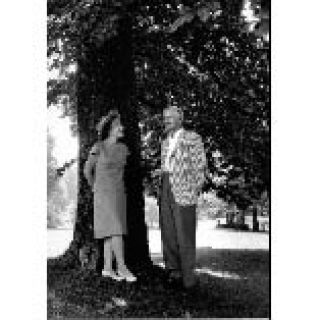When a work of art is complete, it belongs as much to the viewer as to the artist.
The island’s Bloedel Reserve offers a compelling take on that theory, applied to an entire landscape.
“Mr. Bloedel hoped the visitor would be moved psychologically, physically, perhaps spiritually…he was not interested in affecting them intellectually,” said executive director Richard Brown.
Bloedel and his wife, Virginia, purchased the house near Agate Passage in 1952 as a retirement residence. She liked the house, Brown said; he liked the 76 acres that came with it. So after adding basics like heating to what had been just a summer home, they spent the next 15 or more years shaping the generous landscape to create a dramatic sanctuary that included a waterfall, a Japanese garden, and a reflecting pool.
By 1970, Brown said, the Bloedels had come to view their spread, now 150 acres, as “rather special.”
“And so they decided that maybe the public would enjoy this property as much as they did,” he said.
To facilitate strategic public usage, the Bloedels gifted 100 acres to the University of Washington. The fit wasn’t perfect. The property was too far from Seattle for university stakeholders to visit regularly; at the same time, the research and education ideas that UW proposed weren’t quite aligned with Prentice Bloedel’s vision.
He wasn’t interested in specimen plants, or tropical rarities, or horticultural test gardens, Brown said. He was interested in the relationship between people and the environment, and the potential for healing in a harmonious landscape.
In 1974, a group that included Bloedel family members formed the Arbor Fund, which put the running of the estate back into the hands of those on this side of the water. Brown was brought in in 1976.
Ten years later, the Arbor Fund purchased the estate back from the university, closing the financial loop; in 1988, after the Bloedels had moved back to Seattle, it opened the grounds to the public.
For as long as Bloedel has existed in its current form, visits have required advance reservations, not to create exclusivity, Brown said; rather, to ensure a pure experience and preserve the landscape. Its marketing has also been subtle all along; rather than shout its message, the foundation has let the gardens speak for themselves.
With the recent economic downturn, however, board members have had to look at creative ways of generating funds while still maintaining Prentice Bloedel’s mission. Strategies have included a concert series, a yearly garden party fundraiser, and an upcoming fall moon viewing in the Japanese garden. And to mark the Reserve’s 20th anniversary, it will open its gates to visitors for four hours Monday afternoon reservation- and admission-free.
Brown, who will soon retire as director, is hopeful but curious about the future of the Reserve. On the one hand, he said he doesn’t think that fundraising is his forte, and he has confidence that the organization will locate a director with savvy and creativity in that department.
On the other hand, he began working with the Bloedels 32 years ago, knew them well, and feels a deep connection to the mission they established for their former home.
“It’s very possible these days to get $10,000 for a wedding event,” he said. “But what would the impact be on the rest of the place?”



